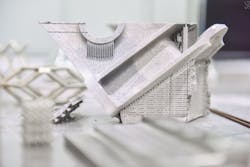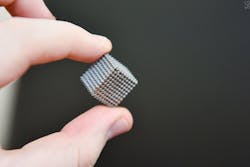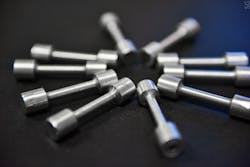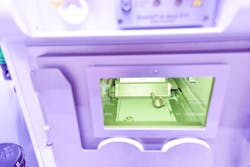Improved 3D Printing Method for Aerospace Composites
Printing aviation parts on a 3D printer can be tricky and downright dangerous. The slightest defect is critical to the safety of the technology.
This problem is especially problematic in the creation of high-tech parts for the aviation and space industries where aluminum 3D printing is commonly used and where the slightest defect is critical to the safety of the technology.
A common issue is that small holes and cavities can form within the part. High residual porosity can result in low density and potential cracks and can be brought on by a range of factors, including the quality and size distribution of the initial material, the incorrect printing parameters and residual gases in powders.
Scientists from the National University of Science and Technology MISIS Catalis Lab in Russia studied the properties associated with 3D printing from aluminum and proposed adding carbon nanofibers to the aluminum powder as a way to ensure a uniform and dense microstructure of printed products. The synthesis of a nanocarbon additive (in-situ composite CNTs/nAl2O3) managed to increase the hardness of products by 1.5 times.
This process of micron-sized aluminum powder modification can improve the quality of 3D printed aerospace composites, noted the scientists. Their findings are published in the international scientific journal Composites Communications.
Changing the chemical and phase composition of the powder for printing by introducing additional components into the main matrix improves its properties, according to Alexander Gromov, a professor at NUST MISIS and the head of the laboratory. “In particular, carbon nanofibers have high thermal conductivity, which helps to minimize temperature gradients between printed layers during product synthesis, at the stage of selective laser melting,” Gromov said. “Thanks to this, the microstructure of the material can be almost completely eliminated from inhomogeneities.”
The technology for the synthesis of nanocarbon additives developed by the research team includes methods of chemical deposition, ultrasonic treatment and IR heat treatment.
The scientists noted that the carbon nanofibers must be a by-product of associated petroleum gas processing. They explained that during its catalytic decomposition, carbon accumulates in the form of nanofibers on dispersed metal particles of the catalyst.
Currently, associated gases are simply burned in the fields, which harms the environment; the application of the new method has environmental significance, noted Gromov.
The study was carried out jointly with specialists from the Boreskov Institute of Catalysis SB RAS.
The research team plans to determine the optimal conditions for selective laser melting of new composite powders, as well as to develop a technology for post-processing and industrial use of synthesized products.
About the Author

Rehana Begg
Editor-in-Chief, Machine Design
As Machine Design’s content lead, Rehana Begg is tasked with elevating the voice of the design and multi-disciplinary engineer in the face of digital transformation and engineering innovation. Begg has more than 24 years of editorial experience and has spent the past decade in the trenches of industrial manufacturing, focusing on new technologies, manufacturing innovation and business. Her B2B career has taken her from corporate boardrooms to plant floors and underground mining stopes, covering everything from automation & IIoT, robotics, mechanical design and additive manufacturing to plant operations, maintenance, reliability and continuous improvement. Begg holds an MBA, a Master of Journalism degree, and a BA (Hons.) in Political Science. She is committed to lifelong learning and feeds her passion for innovation in publishing, transparent science and clear communication by attending relevant conferences and seminars/workshops.
Follow Rehana Begg via the following social media handles:
X: @rehanabegg
LinkedIn: @rehanabegg and @MachineDesign




